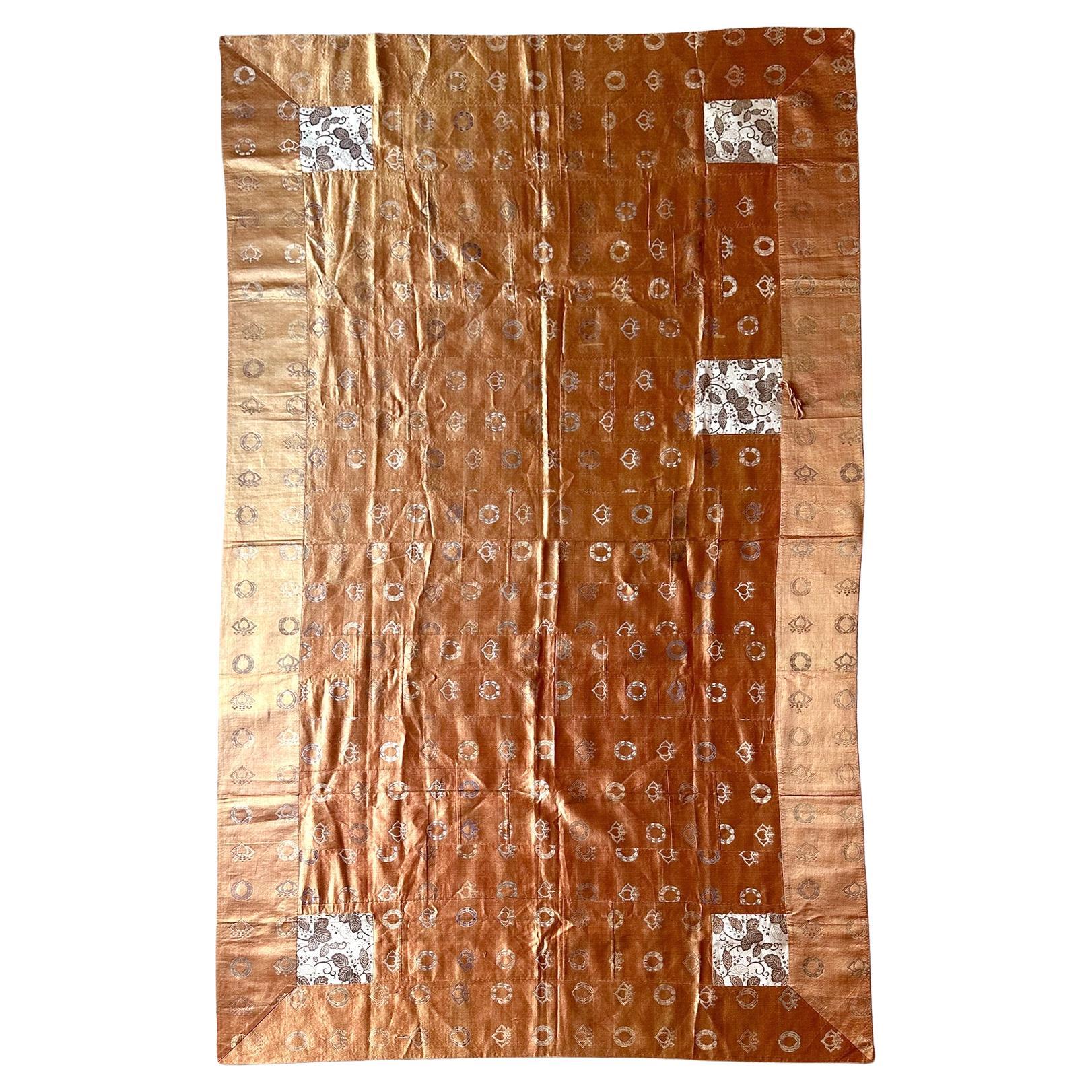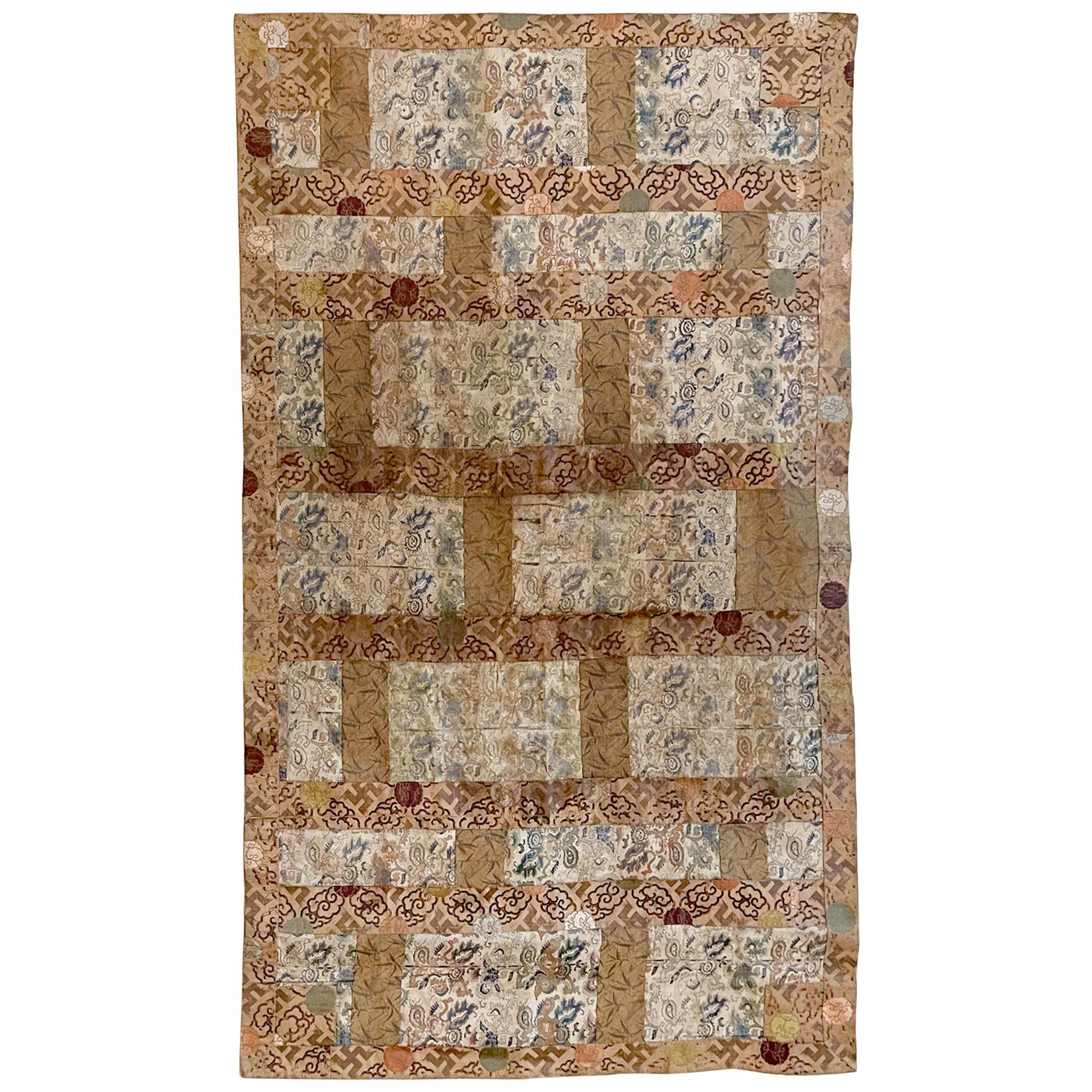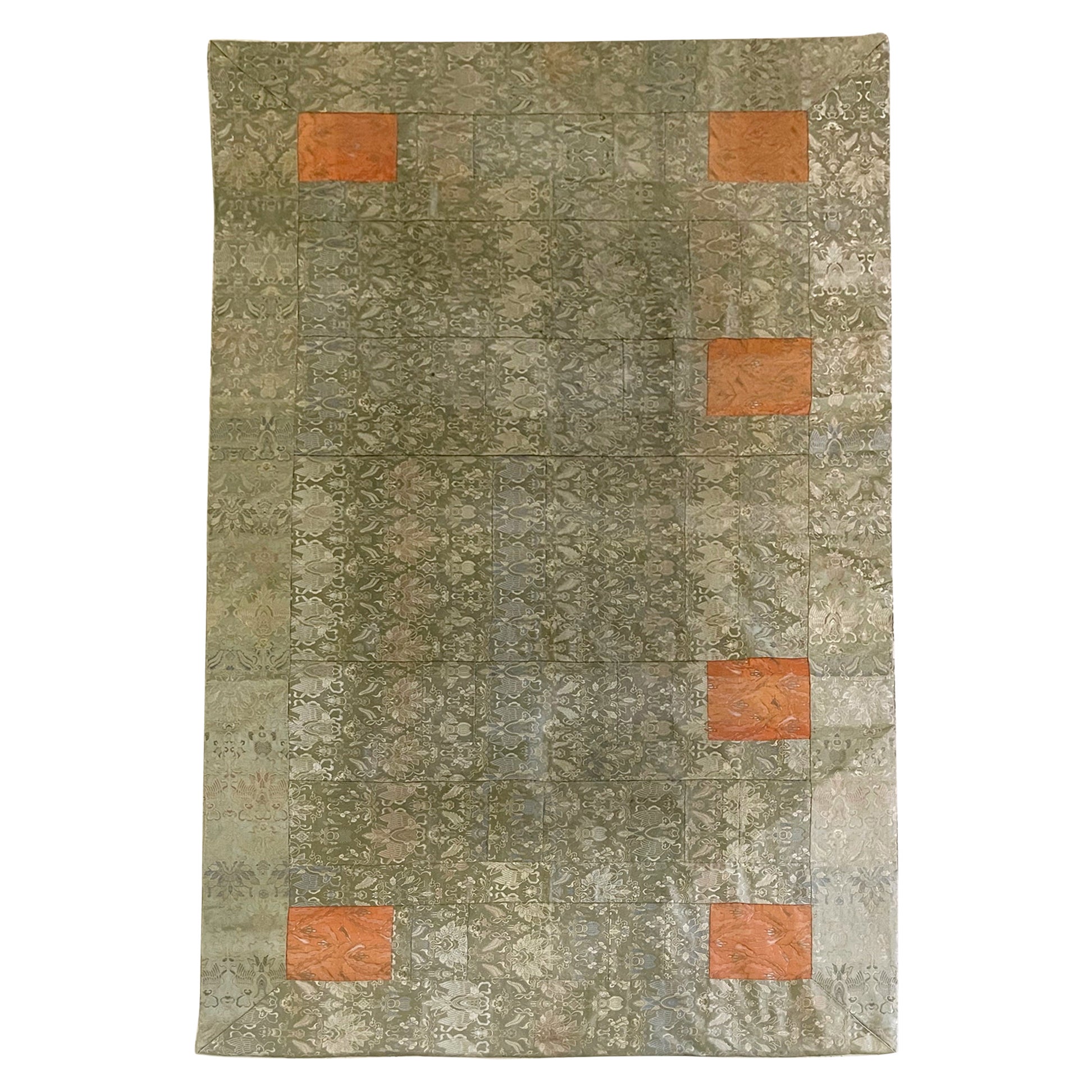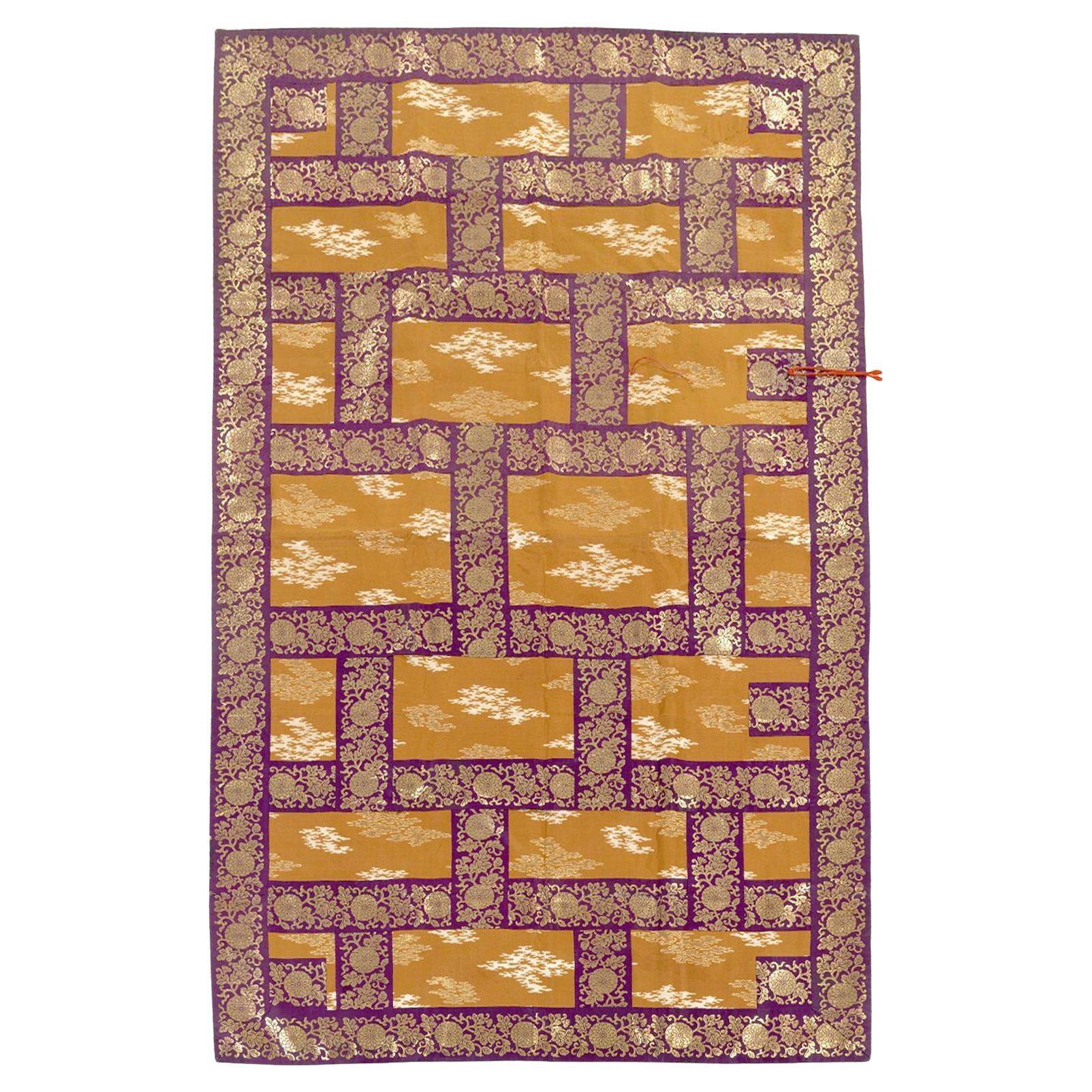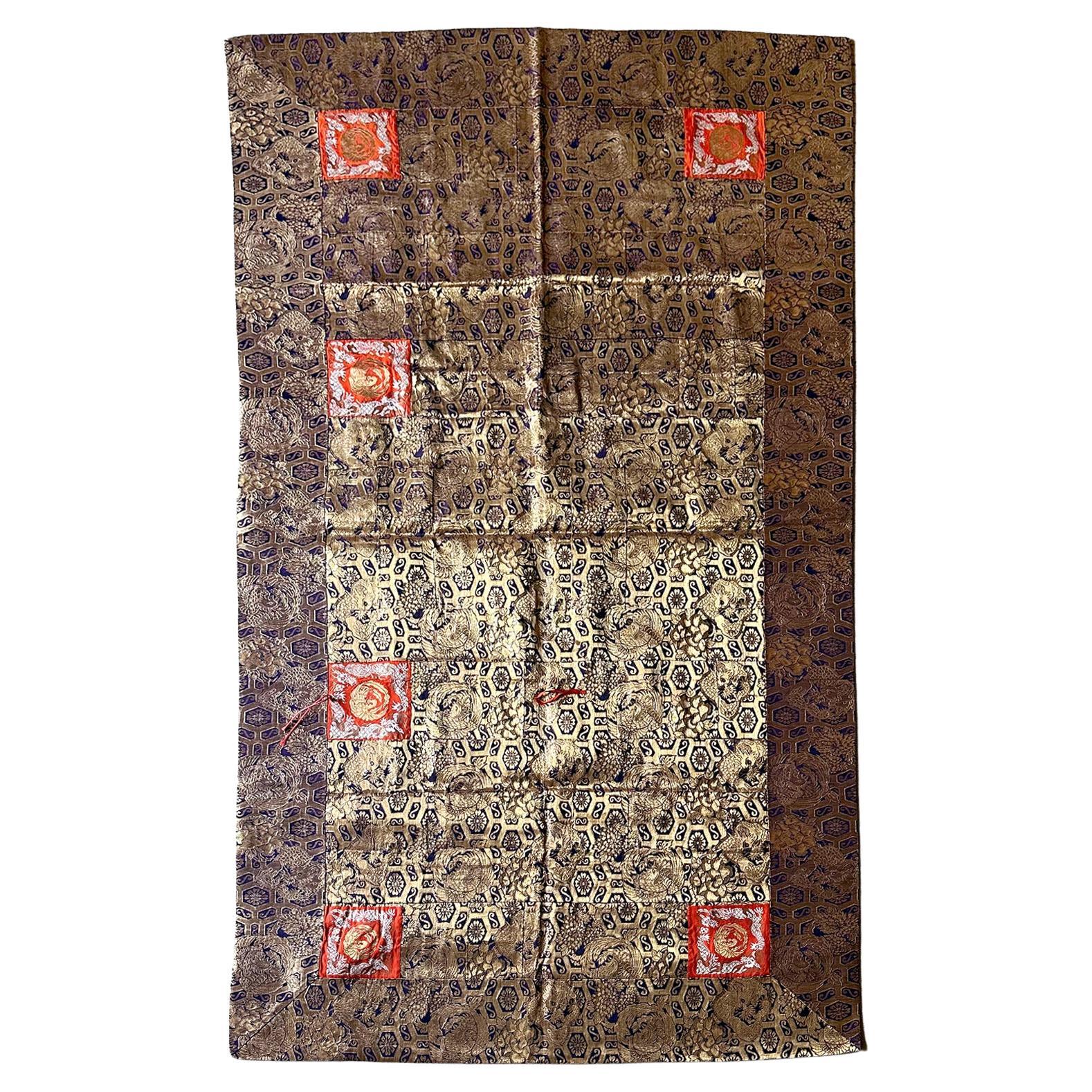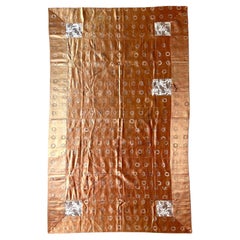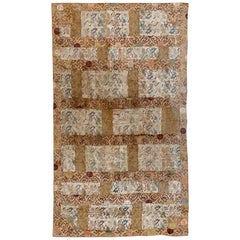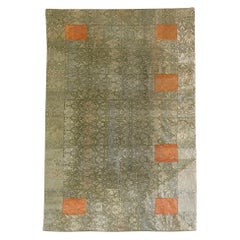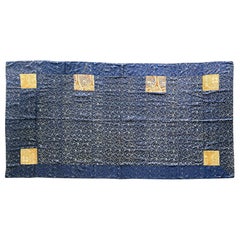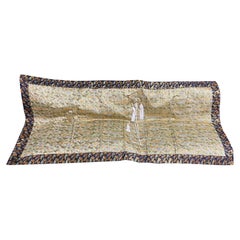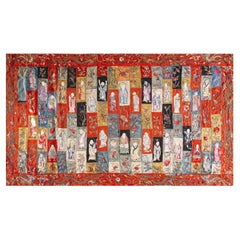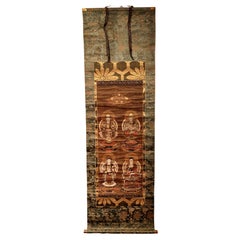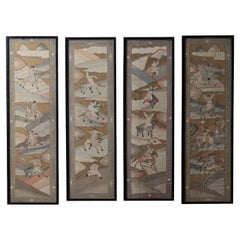Items Similar to Antique Framed Japanese Silk Kesa Monk's Robe Edo Period
Want more images or videos?
Request additional images or videos from the seller
1 of 21
Antique Framed Japanese Silk Kesa Monk's Robe Edo Period
$5,200
£3,945.64
€4,511.49
CA$7,262.99
A$8,075.46
CHF 4,216.56
MX$98,297.97
NOK 53,801.44
SEK 50,409.38
DKK 33,670.06
Shipping
Retrieving quote...The 1stDibs Promise:
Authenticity Guarantee,
Money-Back Guarantee,
24-Hour Cancellation
About the Item
A Japanese Kesa (Monk's Vestment) made from thirteen columns of patchworks of brocades set within a border of the same material. The brocade was woven from a subtle color palette of light brown, gold, beige and white without any bright colors. The elaborate motifs feature a complex and repetitive floral, vines and phoenix deign, set in small blocks interlocked blocks with geometrical pattern. The random patchwork and the mottled colors made the piece more visually intriguing. Five silk squares in contrasting patterns and colors were sewn to the four corners and one longitude side of the Kesa, completing the symbolism of the robe. The four smaller squares in the corners are white silk with scrolling pattern and phoenix roundel represent the Four Heavenly Kings (Shi Tenno); while the much larger square in the middle section with gold peony roundel on a blue background represents the compassionate bodhisattva. The Kesa is housed in a wood floating frame with a silver leaf edge. The lining in the back was removed except for the four corner to reveal the patchwork. Overall, the textile presents beautifully with an attractive air of antiquity.
Kesa is derived from the Sanskrit word kasaya, meaning “dark colored,” a reference to the saffron colored robes worn by early Indian Buddhist monks. It is essentially a rectangular cloth originally sewn from patches of rags, being formless, it serves as a symbolism of the ascetic life of one's choosing. In Japan, since at least the Heian period (794–1185), the kesa has been worn by Buddhist priests as their outermost robe, draped over the left shoulder and attached under the right armpit. While it served some function of protection, it was more a signal of the wearer’s faith, and became increasingly elaborate over the centuries. During the Edo period (1600–1868), many kesa worn were patched together from exquisite silk brocade fabrics that were donated to the temples by members of the aristocracy, ruling military class, or wealthy merchants. By stitching the fabric into a patchwork robe, the monks concentrated their attention on the creation of a devotional work of art, every stitch part of an act of meditation on the teachings of the Buddha. The number of stripes (from 5 to up to 25) indicates the wearer’s rank and the occasion for which it was worn, the highest number of stripes usually only being worn by an abbot during festival ceremonies. The normal daily kesa generally have seven columns. The kesa on offer is more likely a ceremonial robe for special occasion.
- Dimensions:Height: 43 in (109.22 cm)Width: 80 in (203.2 cm)Depth: 1 in (2.54 cm)
- Style:Edo (Of the Period)
- Materials and Techniques:
- Place of Origin:
- Period:
- Date of Manufacture:19th century
- Condition:Wear consistent with age and use. Minor fading. Good antique textile condition. An even patina such as fading from age that results in a lovely antique appearance. Spotted stains and minor loose seam. Frame with some expected wear. Presents nicely.
- Seller Location:Atlanta, GA
- Reference Number:1stDibs: LU945042617342
About the Seller
4.9
Platinum Seller
Premium sellers with a 4.7+ rating and 24-hour response times
Established in 2006
1stDibs seller since 2010
564 sales on 1stDibs
Typical response time: <1 hour
- ShippingRetrieving quote...Shipping from: Atlanta, GA
- Return Policy
Authenticity Guarantee
In the unlikely event there’s an issue with an item’s authenticity, contact us within 1 year for a full refund. DetailsMoney-Back Guarantee
If your item is not as described, is damaged in transit, or does not arrive, contact us within 7 days for a full refund. Details24-Hour Cancellation
You have a 24-hour grace period in which to reconsider your purchase, with no questions asked.Vetted Professional Sellers
Our world-class sellers must adhere to strict standards for service and quality, maintaining the integrity of our listings.Price-Match Guarantee
If you find that a seller listed the same item for a lower price elsewhere, we’ll match it.Trusted Global Delivery
Our best-in-class carrier network provides specialized shipping options worldwide, including custom delivery.More From This Seller
View AllAntique Japanese Embroidered Silk Kesa Monk's Robe Edo Period
Located in Atlanta, GA
A Japanese Kesa (Monk's Vestment) made from thirteen columns of patchworks of fine shimmering silk fabric of a salmon orange color, the shade of which changed subtly from different a...
Category
Antique 19th Century Japanese Edo Textiles
Materials
Brocade, Silk
Antique Brocade Kesa Monk's Patched Robe Edo Period
Located in Atlanta, GA
Kesa, known as "Jiasha" in Chinese and "Kasaya" in Sanskrit, is an out layer garment worn by the ordained Buddhist monks. Bearing a basic rectangular form, it developed originally in...
Category
Antique Late 18th Century Japanese Edo Textiles
Materials
Textile, Brocade
Antique Japanese Brocade Monk's Robe Kesa Meiji Period
Located in Atlanta, GA
A Japanese Kesa (Monk's Vestment) made from thirteen columns of patchworks of shimmering woven brocades. The elaborate motifs feature repetitive elaborat...
Category
Antique Late 19th Century Japanese Meiji Textiles
Materials
Brocade, Silk
Japanese Monastery Robe Patchwork Kesa with inscription Edo Period
Located in Atlanta, GA
A Japanese Kesa (Monk's Vestment) made from fourteen columns of patchworks of blue brocades with sumptuous woven pattern. The elaborate motifs feature re...
Category
Antique Early 19th Century Japanese Japonisme Textiles
Materials
Brocade, Silk
Antique Silk Kesa Monk's Patched Robe Meiji Period
Located in Atlanta, GA
Kesa, known as "Jiasha" in Chinese and "Kasaya" in Sanskrit, is an out-layer garment worn by the ordained Buddhist monks. Bearing a basic rectangular form, it developed originally in...
Category
Antique 19th Century Japanese Meiji Textiles
Materials
Textile, Brocade
Magnificent Antique Japanese Woven Brocade Kesa Monk's Robe Meiji Period
Located in Atlanta, GA
A stunning Japanese Kesa (Monk's Vestment) made from thirteen columns of patchworks of shimmering woven brocades with luxuriant golden threads. Dated to late 19th century of Meiji Period, the elaborate woven motifs on this kesa feature repetitive roundels dragon and phoenix intermixed with peonies and chrysanthemum blossoms. Two shades of contrasting gold threads were used on a striking purplish-blue background, with a dark metallic thread for the outer border and a brighter thread for the main body. The brilliantly woven fabric was possibly recycled from Noh costumes...
Category
Antique Late 19th Century Japanese Meiji Textiles
Materials
Brocade, Silk
You May Also Like
Japanese Buddhist Monk Priest 7 Column Silk Brocade Kesa Ceremonial Temple Robe
Located in Studio City, CA
A wonderful, beautifully ornamented and somewhat rare fully intact Japanese Buddhist monk/ priest's Kesa ceremonial silk robe featuring various colorful birds in flight.
Kesa (which came from the Chinese word "kasaya") robes have been handmade/handstitched by monks/priests as an act of devotion as ceremonial robes for centuries in various Asian cultures (Japanese, Chinese, Korean, Vietnamese, Indian, etc.). The kesa is a rectangular garment designed to be worn over the left shoulder (see example image). The robes are made (often in a patchwork column pattern ranging from five, seven, nine or more pannels) specifically for fully ordained Buddhist monks, priests and nuns and are made from donations of exquisite textiles from wealthy patrons of Japanese Buddhist temples. The robes were used in daily ceremonies, temple gatherings, and private meditation.
Antique Kesa robes...
Category
Mid-20th Century Japanese Showa Textiles
Materials
Textile, Brocade, Silk
Mid 19th Century Silk Chinese Buddhist Embroidery ( 3' 6'' x 6' 2''- 106 x 188 )
Located in New York, NY
Mid 19th Century Silk Chinese Buddhist Embroidery ( 3' 6'' x 6' 2''- 106 x 188 )
Category
Antique 1840s Chinese Textiles
Materials
Silk
Japanese Buddhist Painting, Hanging Scroll Painting
Located in Greenwich, CT
Japanese Buddhist Painting , Hanging Scroll Painting
Depicted Amituofo and Budhisattva in the painting sitting on the lotus crown seats. Bea...
Category
Antique 19th Century Japanese Paintings and Screens
Materials
Paper
$3,800 Sale Price
34% Off
Chinese Silk Kesi Panels, 19th Century
Located in Savannah, GA
A set of four Chinese silk kesi embroidered panels, Qing Dynasty, 19th Century.
larger pair: 11 ⅞ by 38 ½ inches
smaller: 11 ½ by 37 ½ inches
Category
Antique 19th Century Chinese Textiles
Materials
Silk, Glass, Wood
$9,000 / set
Large Framed Japanese Buddhist Amida Temple Hall Painting, Mid-19th Century
Located in Austin, TX
A large and incredible Japanese painting of a Buddhist temple hall with Amida Nyorai, late Edo or early Meiji period, mid-19th century, Japan. Mounted wit...
Category
Antique Mid-19th Century Japanese Meiji Paintings and Screens
Materials
Brocade, Silk, Acrylic, Wood, Paint
Japanese Buddhist Teaching Painting
Located in Greenwich, CT
Japanese Buddhist teaching painting, set of four paintings with 24 Buddhist stories with Japanese written characters in each story on one screen. Provenance: Purchased from Christie's South Kensington...
Category
Antique 1820s Japanese Edo Paintings and Screens
Materials
Paper
More Ways To Browse
Framed Silk
Framing Antique Textiles
Antique Silk Fabric Silk
Edo Wood
Framed Robe
Buddhist Monks
Japanese Phoenix
Wood Monk
Japanese Wood Block
19th Century Monk
Framed Japanese Textiles
Japanese Monk
Japanese Wood Temple
Edo Frames
Temple Japanese Buddhist
Antique Gold Silk Fabric
Indian Antique House
Japanese Patches
